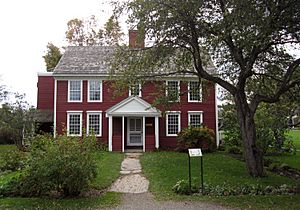Dutton House (Shelburne, Vermont) facts for kids
The Dutton House is a special old building you can visit at the Shelburne Museum in Shelburne, Vermont. It's also known as the Salmon Dutton House, named after the person who built it. This house was the very first building moved to the museum's property to be preserved.
To move the house, workers carefully took it apart. They took many photos before and during the process. They even saved small pieces of the painted walls to help them put it back together exactly as it was. This helped them recreate the beautiful designs inside the house. A special sunburst design painted above a fireplace was also saved and put back in the rebuilt house. Workers also added decorative trim, called dentil molding, to the outside of the house, copying it from another old house in Alburg, Vermont.
Contents
History of the Dutton House
Who Built the Dutton House?
Salmon Dutton built the Dutton House in Cavendish, Vermont, in 1781. He had moved from Massachusetts and worked as a road surveyor, a local judge (called a justice of the peace), and the town's money manager (the treasurer).
How the House Was Used
Like many people in his time, Salmon Dutton used his house for both living and working. His family continued this tradition. They lived in the house until 1900 and used it as a store, an inn (like a hotel), and a boarding house for people who worked in local mills.
The Dutton House was first built in a style called saltbox, which looks like a house with a long, sloping roof at the back. But as the family's needs changed, they added more parts to the house. These additions show a common building style in New England during the 1700s and 1800s, where houses were continuously expanded.
Moving the House to the Museum
In the late 1940s, Redfield Proctor Jr., who was Salmon Dutton's great-great-grandson, offered the house to a group that preserves old buildings. An architect named Frank Chouteau Brown carefully measured and drew the house in 1946.
Later, Proctor gave the house to the Vermont Historical Society. However, in 1950, new road plans threatened the house. So, the society offered it to the Shelburne Museum, where it was carefully moved and rebuilt to be saved for future generations.
Decorating Walls in the 1800s
Different Ways to Decorate Walls
In the 1800s, American homeowners had many ways to decorate the inside of their homes. Fancy paint colors and wallpaper were available as early as 1725. By 1830, thousands of painters offered services like wallpapering, mural painting (painting pictures directly on walls), and stenciling. The Shelburne Museum has examples of all these types of wall decorations.
Wealthy families often bought wallpaper from France and England to decorate important rooms like living rooms, ballrooms, and dining rooms. These wallpapers often showed beautiful landscapes and had bright colors and bold patterns that could be seen even in dim candlelight.
Mural Painting and Stenciling
Mural painting was another way to decorate walls. It was often less expensive than imported wallpaper. Artists like Jonathan Poor and his partner, Paine, traveled around Maine offering to paint murals. They would charge about $10 to paint an entire room. The museum has a painted design from above a fireplace that Poor and Paine created around 1830. These paintings show busy harbors, farms, and forests, and are great examples of this type of art.
In the early 1800s, traveling artists would also stencil walls. They would cut patterns from thin wood or heavy paper. Then, they would use these patterns to decorate walls and furniture. These artists often worked in exchange for a place to stay and food. The Stencil House at the museum shows many stenciled patterns, including grape leaves, vases of flowers, and patriotic eagles.
Stencils in the Dutton House
The stencil paintings in the Dutton House are found in the four front rooms. Most of these designs are along the edges of the plaster walls and date back to about 1800. A special sunburst design is painted above the fireplace in one of the upstairs rooms. This is the only part of the plaster that was replaced after the house was moved from Cavendish.
Small pieces of each border design were saved from the four rooms. These pieces helped guide the workers when the house was rebuilt at Shelburne. Similar stencil designs to those in the Dutton House have been found in other old houses in Massachusetts, Vermont, and New Hampshire. One design, a freehand drawing in a downstairs room, is also seen in the Grimes House in Keene, New Hampshire. It's thought that artists named Jothan Stearns or Jedutham Bullin might have painted the walls in the Grimes House, so one of them might have also decorated the Dutton House.
See also
- Electra Havemeyer Webb
- Redfield Proctor Jr.
- List of the oldest buildings in Vermont


